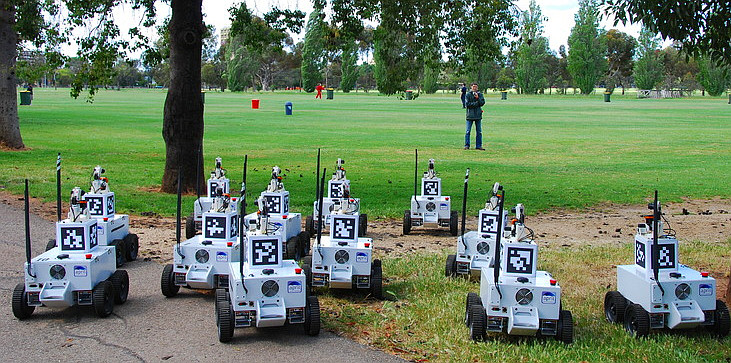Journal of Field Robotic, 2012
Edwin Olson, Johannes Strom, Ryan Morton, Andrew Richardson,
Pradeep Ranganathan, Robert Goeddel, Mihai Bulic, Jacob Crossman, and
Bob Marinier
 Abstract -
Tasks like search-and-rescue and urban reconnaissance benefit from large numbers
of robots working together, but high levels of autonomy are needed in order to
reduce operator requirements to practical levels. Reducing the reliance of such
systems on human operators presents a number of technical challenges including
automatic task allocation, global state and map estimation, robot perception,
path planning, communications, and human-robot interfaces. This paper describes
our 14-robot team, designed to perform urban reconnaissance missions, that won
the MAGIC 2010 competition. This paper describes a variety of autonomous systems
which require minimal human effort to control a large number of autonomously
exploring robots. Maintaining a consistent global map, essential for autonomous
planning and for giving humans situational awareness, required the development
of fast loop-closing, map optimization, and communications algorithms. Key to
our approach was a decoupled centralized planning architecture that allowed
individual robots to execute tasks myopically, but whose behavior was
coordinated centrally. In this paper, we will describe technical contributions
throughout our system that played a significant role in the performance of our
system. We will also present results from our system both from the competition
and from subsequent quantitative evaluations, pointing out areas in which the
system performed well and where interesting research problems remain.
Abstract -
Tasks like search-and-rescue and urban reconnaissance benefit from large numbers
of robots working together, but high levels of autonomy are needed in order to
reduce operator requirements to practical levels. Reducing the reliance of such
systems on human operators presents a number of technical challenges including
automatic task allocation, global state and map estimation, robot perception,
path planning, communications, and human-robot interfaces. This paper describes
our 14-robot team, designed to perform urban reconnaissance missions, that won
the MAGIC 2010 competition. This paper describes a variety of autonomous systems
which require minimal human effort to control a large number of autonomously
exploring robots. Maintaining a consistent global map, essential for autonomous
planning and for giving humans situational awareness, required the development
of fast loop-closing, map optimization, and communications algorithms. Key to
our approach was a decoupled centralized planning architecture that allowed
individual robots to execute tasks myopically, but whose behavior was
coordinated centrally. In this paper, we will describe technical contributions
throughout our system that played a significant role in the performance of our
system. We will also present results from our system both from the competition
and from subsequent quantitative evaluations, pointing out areas in which the
system performed well and where interesting research problems remain.